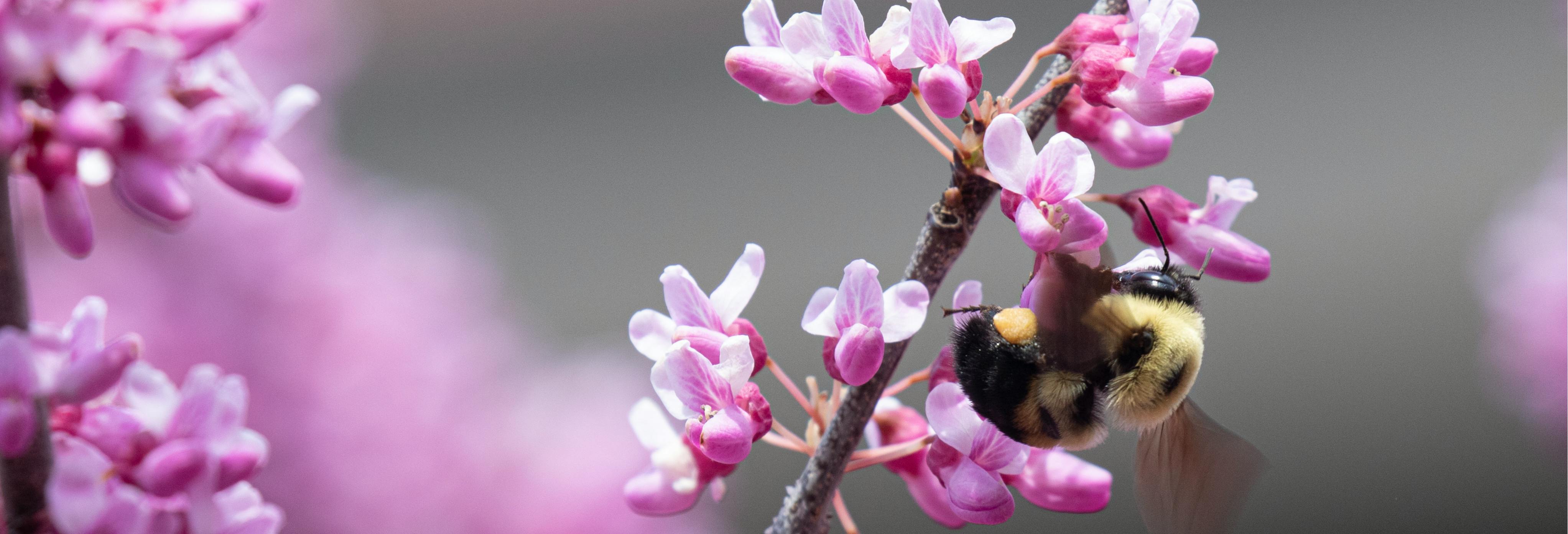Frequently Asked Questions:

Click on this article to read answers to the questions we hear most often:
- What should I plant?
- Where can I get plants?
- Is this relevant for me if I don't live in Somerville?
- What about rats?
- What about allergies?
- What about stinging insects?
What should I plant?
The Pollinator Action Plan has so many resources for you! Start by looking at the "Pollinator Pantry" section of the plan here.
There you'll find a "Top 10" list that supports the largest number of Somerville pollinators. There are also plant lists for our "mascot" pollinators (see the videos below). There are garden designs for many different kinds of site conditions (shady, wet, dry, sunny, etc.). There are designs for garden pots, if all you have is a stoop! There are lists of annuals, vines, ferns, and grasses. There are recommendations for low-mow lawns and lawn conversion.
In other words, there is something for everyone and (hopefully) every kind of pollinator.
Where can I get plants?
New England is home to many native plant nurseries. Grow Native Massachusetts compiled a list of native plant nurseries and seed sources. Homegrown National Park also has a national native plant resource directory. Source plants that have not been pre-treated with pesticides, especially neonicotinoids. If your local garden center/nursery doesn't do this already, ask them to!
Additionally, local groups like the Somerville Garden Club, the Somerville Community Growing Center, and the MAMAS Gardening Collective are great resources. Sometimes they host plant- or seed-giveaways, plant swaps, and they want to make gardening accessible to all. The Tufts Pollinator Initiative free seed library at 574 Boston Ave in Medford and the “Somerville Plant Exchange (Sales Prohibited)” Facebook group are also good resources. All these groups may be able to help you source plants, if you experience any barriers to doing so on your own.
Is this relevant for me if I don't live in Somerville?
In short, yes! And the more of us that act, the more impact we will make. So join us!
The data analysis in this plan is very Somerville-specific, but the landscape maintenance practices apply to us all. Pollinators across the globe all need pollen/nectar and places to nest. Actions like leaving the leaves or not cutting back perennial stalks are great for pollinators in any garden.
If you live in New England, the plant lists and garden designs will likely work for your site too. They feature plants native to the east coast (east of the Mississippi and north of Virginia). Before you make final plant choices, though, be sure to check that the species is appropriate for your climate, your site conditions, and that it is not listed as an invasive species in your community.
Some areas, like Cape Cod, may have very different climates and native plant communities. If you live in a climate that differs substantially from Somerville, be sure to double check that the plants can survive on your site.
Finally, reporting insect observations on iNaturalist is helpful across the region! Maybe the town you live in will want to develop their own Pollinator Action Plan one day. Data on local pollinators benefits any future planning or conservation effort.
What about rats?
Cities all over are dealing with large rat populations. We know that many people worry that gardens contribute to this issue. But rats are looking for a food source first! For example, overflowing trash cans will draw rats to an area. A garden nearby may provide a convenient nesting spot, but removing a food source is the best remedy.
Many of the recommendations in this plan also align with design ideas that deter rats. For example, rats like to burrow in mulch. This plan proposes reducing how much mulch you use and leaving some areas bare. We also know that rats like to be in areas where plants are dense and there are thick groundcovers. But pollinators do not need a thick layer of plants to thrive. Patches of garden separated by some bare ground or even a group of pots will do the trick for our insect friends.
If you have further concerns, please feel free to reach out to Somerville's Rodent Control Program for support. More information can be found here: https://www.somervillema.gov/departments/programs/rodent-control-and-public-education
What about allergies?
Pollen allergies are a very common concern. Some people may worry that planting pollinator gardens will increase the amount of pollen in the air. BUT, many of the recommended plants require animal pollination. Species that are the worst for seasonal allergies are actually pollinated by wind! A common misconception is that native plants (like goldenrod) are contributing to allergies. Really, they just bloom at the same time as other wind pollinated plants (i.e., ragweed). Planting for pollinators will have little to no impact on seasonal pollen allergies.
What about stinging bees and wasps?
Many people are afraid of insects or have serious insect allergies. However, it is important to note that many flower-visiting insects do not sting! Of the pollinators in Somerville, only bees and wasps possess stingers. Butterflies, moths, beetles, and flies won't harm you. Also, the vast majority of species are solitary (they don't defend a nest) and unlikely to sting. This means that planting flowers can be considered a safe activity even when it does attract bees and wasps to the garden. When observing bees and wasps on flowers, just keep a respectful distance. And add signage to alert others to look out for insects in your garden.
Avoid approaching the nests of ground-nesting yellowjackets (social wasps), aerial yellowjackets, or bald-faced hornets (social wasps). These are the most aggressive stinging insects among Somerville’s pollinators.


